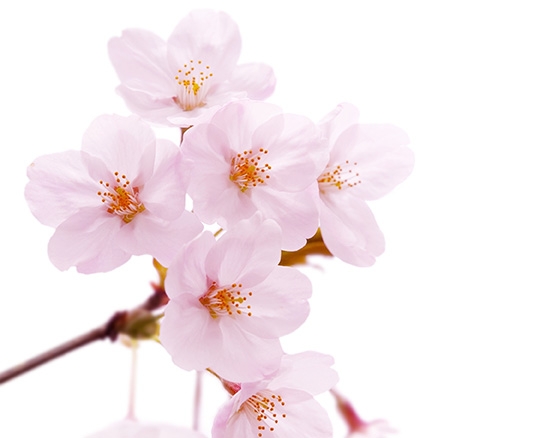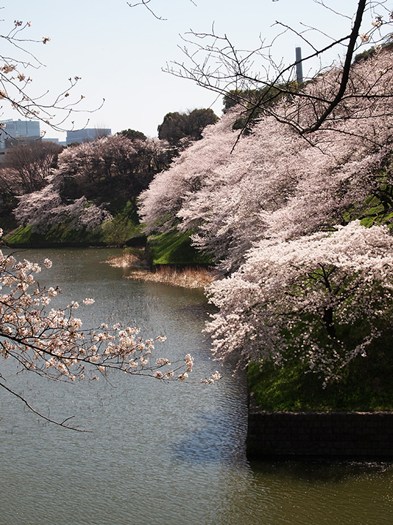TOKYO - Though sakura, or cherry blossoms, bloom just a brief two to three weeks every spring, these delicate pink flowers are one of Japan’s defining hallmarks, and for good reason.
Every year, from the end of March to mid April, the country is transformed by bursts of pale pink petals shivering against blue spring skies, and the whole country gears up for another festive sakura season. One look at the trees in full, halo-esque bloom and I’m converted. It’s no wonder that sakura fever grips Japan every spring, or that the cherry blossom is such a prominent feature of Japanese art.
For centuries, the sakura has been featured in music, on kimono prints, stoneware, in dances and plays and is even a common name. These ephemeral blossoms are intricately linked with Japanese culture.
Once the flowers reach full bloom, a simple tree-lined path transforms into a charming romantic promenade, or a tiny unobtrusive garden becomes a miniature haven where one can sit among the dappled and delicate shadows of the trees. As the flowers unfold, major parks throughout Japan are flooded with visitors for hanami, or cherry-blossom viewing parties.


Above: Cherry blossom season is like a religious experience for the Japanese and they are everywhere.
Along the Meguro River, one of Tokyo’s prime cherry blossom viewing locations, the calls of vendors echo on the air and the aroma of fried Japanese delicacies makes my stomach growl. No celebration of sakura is complete without a bottomless supply of snacks and beer, and the vendors lining the river are only too happy to oblige. I end up with a steaming carton of yakisoba — fried noodles mixed with pork, sweet soy sauce and garnished with flakes of seaweed. It’s practically the official street food of Japan.
On the river, pale petals dust the sparkling water like confetti, adding to the festive atmosphere, while seasonal sakura champagne sparkles pink in the glasses of passersby as they stroll alongside the water. A friend explains that for Japanese, cherry blossoms invoke mono no aware, a Buddhist concept that is somewhat difficult to translate. But if I understand her correctly it means something along the lines of the appreciation and wistful longing for the transience of all things.
Though gorgeous, the riverside offers little space to sit and marvel, and I’m forced to walk with the rest of the slow but relentless crowd. So the following day I opt to meet friends for a hanami picnic at Chidori-ga-fuchi Park, one of the most beautiful places in Tokyo to see the blossoms, which draw about one million people every season.
I step out of the train and into the ordered chaos of the station. Police shout in Japanese at the bustling crowd, which wriggles like a giant beast toward the gates. “For Chidori-ga-fuchi, please use exit 3b! Exit 3b for Chidori-ga-fuchi Park!”
The park is named for the nearby moat which fronts Japan’s Imperial Palace. Tendril-like branches covered in blossoms sway gracefully over the water as rowboats drift by underneath. People group at the edge of the moat, staring transfixed through their camera lenses, determined to perfectly capture the beauty of the trees in their prime.
Though my friends and I arrive a little after noon, the park is already full of people and it takes us a while to find a spot. Many have already staked their claim under the shade of a sakura tree, and the ground is covered in blue tarps or blankets, the air alive with music and happy voices. We eventually find a lone tree and pull out our convenience store bento box lunches and a slew of sakura-inspired snacks. Around this time of year, anything that can be made in sakura flavour surely will be: sweet sakura lattes, sakura sake (sake with a delicious cherry infusion), pink and chewy sakura mochi (rice cakes) and even French fries from McDonald’s get served with a seaweed and sakura seasoning powder — something of an acquired taste.
The beer cans are popped open, the cards are passed, and we get down to one of my favourite Japanese pastimes. We stay there eating, drinking and chatting until the sun begins to set and a chill creeps into the air. Though we decide to head back, many stay for yozakura — nighttime cherry blossom viewing. Once the sun sets, artfully placed lamps and decorative lanterns cast the blossoms in a romantic glow, and the petals reflect ghostly white off the black mirror of the water, haunting and lovely.
Come sakura time, the whole of Japan prays for good weather, disdaining spring rain or strong winds that will wash the petals away early, hoping to see the blossoms hang on as long as possible. But as all Japanese know, everything has its season, and as the last of the flowers fall away people flock to the parks for one last stroll among the trees.
Now most of the petals dust the ground and those that remain slowly fall and whirl above us, the saddest and yet the most beautiful part of cherry blossom season, the embodiment of mono no aware.
Information
Air Canada offers daily flights to Tokyo and Osaka from several cities in Canada. / Tour East Holidays has many affordable tour packages to Japan. Go to
www.toureast.com to find out more.
About the Author
Amanda Taylor is a freelance writer who has lived in Tokyo and travelled all over Asia. She's written for Japan's top magazines, Time Out Tokyo and Metropolis. Her travel choices are suspiciously linked to how spicy a country's food happens to be: the hotter the better. From trekking through ancient ruins to sunbathing on private beaches, she's down for anything that involves a plane ticket and a passport.